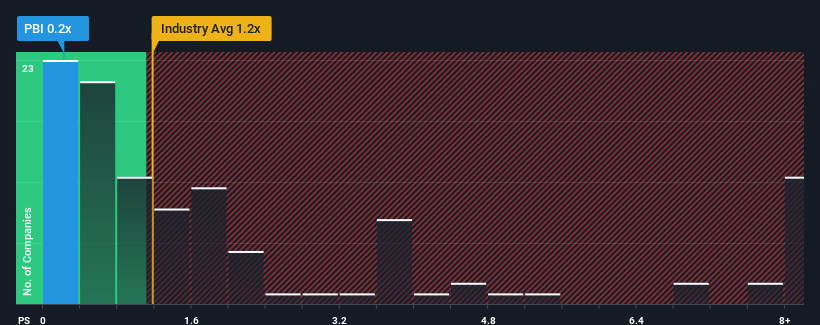- United States
- /
- Commercial Services
- /
- NYSE:PBI
Pitney Bowes Inc.'s (NYSE:PBI) Business And Shares Still Trailing The Industry

When close to half the companies operating in the Commercial Services industry in the United States have price-to-sales ratios (or "P/S") above 1.2x, you may consider Pitney Bowes Inc. (NYSE:PBI) as an attractive investment with its 0.2x P/S ratio. Although, it's not wise to just take the P/S at face value as there may be an explanation why it's limited.
See our latest analysis for Pitney Bowes

How Has Pitney Bowes Performed Recently?
Pitney Bowes hasn't been tracking well recently as its declining revenue compares poorly to other companies, which have seen some growth in their revenues on average. The P/S ratio is probably low because investors think this poor revenue performance isn't going to get any better. If this is the case, then existing shareholders will probably struggle to get excited about the future direction of the share price.
Keen to find out how analysts think Pitney Bowes' future stacks up against the industry? In that case, our free report is a great place to start.Do Revenue Forecasts Match The Low P/S Ratio?
In order to justify its P/S ratio, Pitney Bowes would need to produce sluggish growth that's trailing the industry.
Retrospectively, the last year delivered a frustrating 7.7% decrease to the company's top line. This means it has also seen a slide in revenue over the longer-term as revenue is down 8.1% in total over the last three years. So unfortunately, we have to acknowledge that the company has not done a great job of growing revenue over that time.
Looking ahead now, revenue is anticipated to slump, contracting by 0.4% during the coming year according to the sole analyst following the company. With the industry predicted to deliver 9.4% growth, that's a disappointing outcome.
In light of this, it's understandable that Pitney Bowes' P/S would sit below the majority of other companies. However, shrinking revenues are unlikely to lead to a stable P/S over the longer term. There's potential for the P/S to fall to even lower levels if the company doesn't improve its top-line growth.
The Bottom Line On Pitney Bowes' P/S
While the price-to-sales ratio shouldn't be the defining factor in whether you buy a stock or not, it's quite a capable barometer of revenue expectations.
With revenue forecasts that are inferior to the rest of the industry, it's no surprise that Pitney Bowes' P/S is on the lower end of the spectrum. As other companies in the industry are forecasting revenue growth, Pitney Bowes' poor outlook justifies its low P/S ratio. It's hard to see the share price rising strongly in the near future under these circumstances.
And what about other risks? Every company has them, and we've spotted 2 warning signs for Pitney Bowes (of which 1 makes us a bit uncomfortable!) you should know about.
If these risks are making you reconsider your opinion on Pitney Bowes, explore our interactive list of high quality stocks to get an idea of what else is out there.
New: Manage All Your Stock Portfolios in One Place
We've created the ultimate portfolio companion for stock investors, and it's free.
• Connect an unlimited number of Portfolios and see your total in one currency
• Be alerted to new Warning Signs or Risks via email or mobile
• Track the Fair Value of your stocks
Have feedback on this article? Concerned about the content? Get in touch with us directly. Alternatively, email editorial-team (at) simplywallst.com.
This article by Simply Wall St is general in nature. We provide commentary based on historical data and analyst forecasts only using an unbiased methodology and our articles are not intended to be financial advice. It does not constitute a recommendation to buy or sell any stock, and does not take account of your objectives, or your financial situation. We aim to bring you long-term focused analysis driven by fundamental data. Note that our analysis may not factor in the latest price-sensitive company announcements or qualitative material. Simply Wall St has no position in any stocks mentioned.
About NYSE:PBI
Pitney Bowes
Operates as a technology-driven company that provides SaaS shipping solutions, mailing innovation, and financial services to small businesses, large enterprises, and government entities around the world.
Undervalued slight.
Similar Companies
Market Insights
Community Narratives



